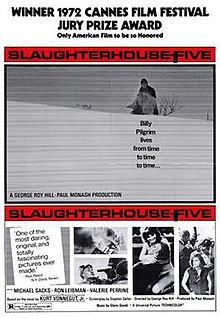Slaughterhouse-Five (film)
| Slaughterhouse-Five | |
|---|---|
 original film poster | |
| Directed by | George Roy Hill |
| Screenplay by | Stephen Geller |
| Based on | Slaughterhouse-Five or The Children's Crusade by Kurt Vonnegut, Jr. |
| Produced by | Paul Monash |
| Starring | Michael Sacks Ron Leibman Valerie Perrine |
| Cinematography | Miroslav Ondrícek |
| Edited by | Dede Allen Stephen Rotter (assistant editor) |
| Music by | Glenn Gould |
Production company | Vanadas Productions |
| Distributed by | Universal Pictures |
Release date |
|
Running time | 104 minutes |
| Country | United States |
| Language | English |
Slaughterhouse-Five is a 1972 science fiction film based on Kurt Vonnegut's 1969 novel of the same name about a writer who tells a story in random order of how he was a soldier in World War II and was abducted by aliens. The screenplay is by Stephen Geller and the film was directed by George Roy Hill. It stars Michael Sacks, Ron Leibman, and Valerie Perrine, and features Eugene Roche, Sharon Gans, Holly Near, and Perry King. The scenes set in Dresden were filmed in Prague.[1] The other scenes were filmed in Minnesota.
Vonnegut wrote about the film soon after its release, in his preface to Between Time and Timbuktu:
- "I love George Roy Hill and Universal Pictures, who made a flawless translation of my novel Slaughterhouse-Five to the silver screen ... I drool and cackle every time I watch that film, because it is so harmonious with what I felt when I wrote the book."
Plot
The film follows the novel in presenting a first-person narrative from the point of view of Billy Pilgrim (Sacks), who becomes "unstuck in time" and experiences the events of his life in a seemingly random order, including a period spent on the alien planet of Tralfamadore. Emphasis is placed on his experiences during World War II, including the firebombing of Dresden, as well as time spent with fellow prisoners of war Edgar Derby (Roche) and the psychopathic Paul Lazzaro (Leibman). His life as a husband to Valencia (Gans) and father to Barbara (Near) and Robert (King) are also depicted, as they live and sometimes even enjoy their life of affluence in Ilium, New York. A "sink-or-swim" scene with Pilgrim's father is also featured. The scenes of extraterrestrial life on Tralfamadore feature Hollywood starlet Montana Wildhack (Perrine).
Cast
- Michael Sacks as Billy Pilgrim
- Ron Leibman as Paul Lazzaro
- Eugene Roche as Edgar Derby
- Sharon Gans as Valencia Merble Pilgrim
- Valerie Perrine as Montana Wildhack
- Holly Near as Barbara Pilgrim
- Perry King as Robert Pilgrim
- Kevin Conway as Roland Weary
- Friedrich von Ledebur as German Leader
- Ekkehardt Belle as Young German Guard
- Sorrell Booke as Lionel Merble
- Roberts Blossom as Wild Bob Cody
- John Dehner as Professor Rumfoord
- Gary Waynesmith as Stanley
- Richard Schaal as Howard W. Campbell Jr.
- Gilmer McCormick as Lily Rumfoord
- Stan Gottlieb as Hobo
- Karl-Otto Alberty as German Guard - Group Two
- Henry Bumstead as Eliot Rosewater
- Lucille Benson as Billy's Mother
- John Wood as English Officer, credited as Tom Wood
Music
Slaughterhouse-Five is the first of two feature films for which Glenn Gould supplied the music; Bach Concerto #5 in F Minor, BWV 1056, and Concerto #3 in D Major, BWV 1054 were recorded at Columbia Studios with the Columbia Symphony orchestra; some selections came from existing recordings, and two featured other artists, including Rudolph Serkin, piano, with Casals conducting Brandenburg Concerto #4 in G Major, BWV 1049, III Presto. The film used such a small amount of music that the soundtrack album added atmospheric excerpts from Douglas Leedy's synthesized triple album Entropical Paradise.
The prolonged rendition of the final movement of Bach's fourth Brandenburg concerto accompanies a cinematic montage as the main character first encounters the city of Dresden.
Awards
The film won the Prix du Jury at the 1972 Cannes Film Festival,[2] as well as a Hugo Award and Saturn Award. Both Hill and Geller were nominated for awards by their respective guilds. Sacks was nominated for a Golden Globe.
See also
References
- ^ Canby, Vincent. "New York Times movies pages". The New York Times. Retrieved 2010-05-23.
- ^ "Festival de Cannes: Slaughterhouse-Five". festival-cannes.com. Retrieved 2009-04-13.
External links
- Slaughterhouse-Five at IMDb
- Slaughterhouse-Five at Rotten Tomatoes
- Template:Amg movie
- Review of the film by Vincent Canby
- Glenn Gould at the Movies, a Sony Classical recording with music from the film (including this 46-second clip[permanent dead link] in WAV format)
- 1972 films
- 1970s science fiction comedy-drama films
- 1970s satirical films
- American satirical films
- American films
- Anti-war films about World War II
- American science fiction comedy-drama films
- Films about psychiatry
- Films based on American novels
- Films based on science fiction novels
- Films based on works by Kurt Vonnegut
- Films directed by George Roy Hill
- English-language films
- Western Front of World War II films
- Films set in Germany
- Films set in New York (state)
- Films shot in the Czech Republic
- Hugo Award for Best Dramatic Presentation winning works
- American nonlinear narrative films
- Films about time travel
- World War II prisoner of war films
- Universal Pictures films
